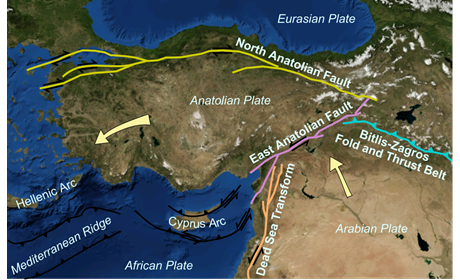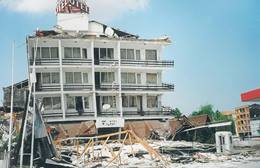North Anatolian Fault, Turkey

The North Anatolian fault stretches across northern Turkey and its movement is strike-slip in nature just like the ancient movement seen at the Great Glen Fault in Scotland. The fault runs along the boundary between the Eurasian plate and the smaller Anatolian plate but movement in the area is controlled by collision of the larger Arabian plate to the south and the Eurasian plate to the north. The fault is a transform fault with the Anatolian Plate and the Eurasian Plate sliding past each other
 |
|
| Building damage from the Duzce earthquake: © Halit Edip Özcan |
This fault has been the site of a number of disastrous earthquakes including the 1939 Erzincan earthquake which resulted in the death of more than 32,000 people and injured more than 100,000. Since then, there have been seven further earthquakes measuring over 7.0 in magnitude including the7.6-magnitude Golcuk-Kocaeli earthquake which directly struck the city of Izmit in 1999, killing over 17,100 people, and displacing 250,000 others.
 |
|
| Regional plate tectonics: © Molear 3 |
Related Links
Other sites
Badcall
- Twin: Windward Isles
Cwm Idwal
- Twin: Mount Pinatubo
Sperrin Mountains
- Twin: Sierra Nevada
Southern Uplands
- Twin: Nankai
Ben Arnaboll
- Twin: Glarus Thrust
Outer Isles
- Twin: Tohoku Earthquake
Clogherhead and Shannon
- Twin: Papua New Guinea
Cairngorms
- Twin: New Hampshire Granites
Great Glen Fault
- Twin: North Anatolian Fault
The Lizard
- Twin: Troodos Ophiolite
Yoredales
- Twin: Antarctica
Stanage Edge
- Twin: Ganges Delta
Hartland Quay
- Twin: Zagros Range
Amroth-Saundersfoot-Tenby
- Twin: Salt Range, Pakistan
Vale of Eden
- Twin: East African Rift Valley
Zechstein
- Twin: Sicily
Alderley Edge
- Twin: Navajo Sandstone
Isle of Skye
- Twin: Mount Kilimanjaro
Lulworth Cove
- Twin: Albania
Giant's Causeway
- Twin: Cascade du Ray Pic
- Twin: Windward Isles
Cwm Idwal
- Twin: Mount Pinatubo
Sperrin Mountains
- Twin: Sierra Nevada
Southern Uplands
- Twin: Nankai
Ben Arnaboll
- Twin: Glarus Thrust
Outer Isles
- Twin: Tohoku Earthquake
Clogherhead and Shannon
- Twin: Papua New Guinea
Cairngorms
- Twin: New Hampshire Granites
Great Glen Fault
- Twin: North Anatolian Fault
The Lizard
- Twin: Troodos Ophiolite
Yoredales
- Twin: Antarctica
Stanage Edge
- Twin: Ganges Delta
Hartland Quay
- Twin: Zagros Range
Amroth-Saundersfoot-Tenby
- Twin: Salt Range, Pakistan
Vale of Eden
- Twin: East African Rift Valley
Zechstein
- Twin: Sicily
Alderley Edge
- Twin: Navajo Sandstone
Isle of Skye
- Twin: Mount Kilimanjaro
Lulworth Cove
- Twin: Albania
Giant's Causeway
- Twin: Cascade du Ray Pic
